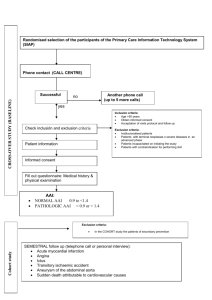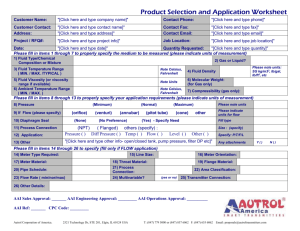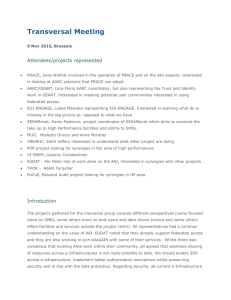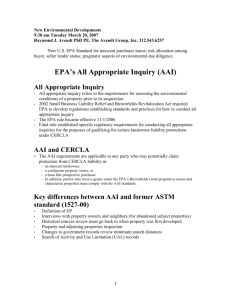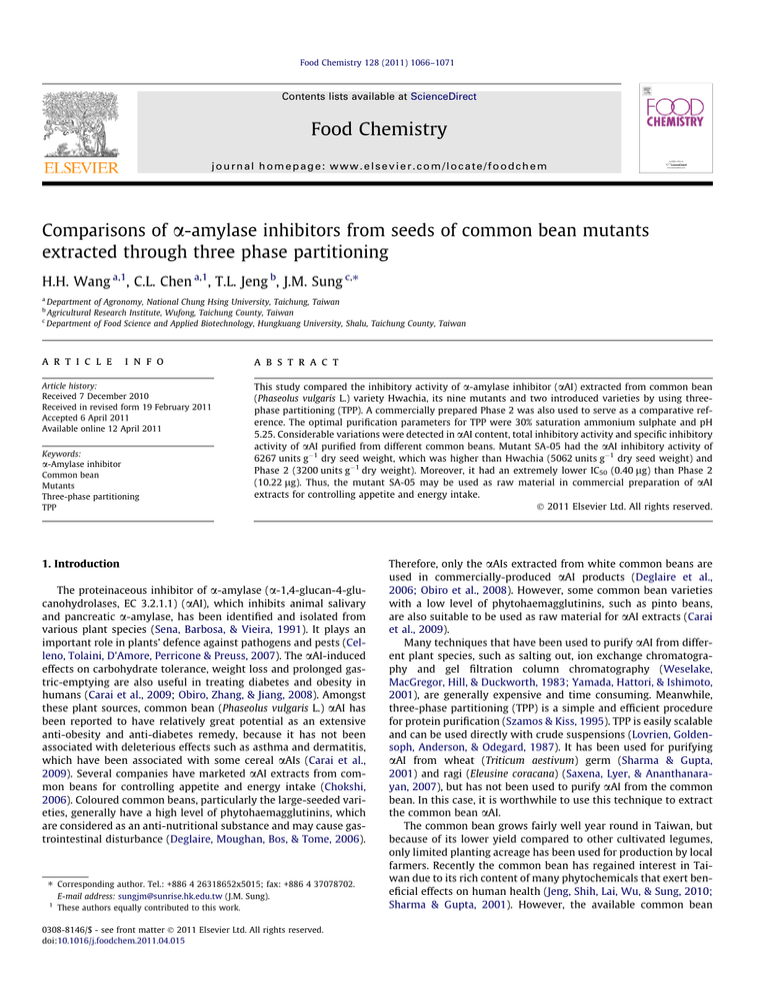
Food Chemistry 128 (2011) 1066–1071
Contents lists available at ScienceDirect
Food Chemistry
journal homepage: www.elsevier.com/locate/foodchem
Comparisons of a-amylase inhibitors from seeds of common bean mutants
extracted through three phase partitioning
H.H. Wang a,1, C.L. Chen a,1, T.L. Jeng b, J.M. Sung c,⇑
a
Department of Agronomy, National Chung Hsing University, Taichung, Taiwan
Agricultural Research Institute, Wufong, Taichung County, Taiwan
c
Department of Food Science and Applied Biotechnology, Hungkuang University, Shalu, Taichung County, Taiwan
b
a r t i c l e
i n f o
Article history:
Received 7 December 2010
Received in revised form 19 February 2011
Accepted 6 April 2011
Available online 12 April 2011
Keywords:
a-Amylase inhibitor
Common bean
Mutants
Three-phase partitioning
TPP
a b s t r a c t
This study compared the inhibitory activity of a-amylase inhibitor (aAI) extracted from common bean
(Phaseolus vulgaris L.) variety Hwachia, its nine mutants and two introduced varieties by using threephase partitioning (TPP). A commercially prepared Phase 2 was also used to serve as a comparative reference. The optimal purification parameters for TPP were 30% saturation ammonium sulphate and pH
5.25. Considerable variations were detected in aAI content, total inhibitory activity and specific inhibitory
activity of aAI purified from different common beans. Mutant SA-05 had the aAI inhibitory activity of
6267 units g 1 dry seed weight, which was higher than Hwachia (5062 units g 1 dry seed weight) and
Phase 2 (3200 units g 1 dry weight). Moreover, it had an extremely lower IC50 (0.40 lg) than Phase 2
(10.22 lg). Thus, the mutant SA-05 may be used as raw material in commercial preparation of aAI
extracts for controlling appetite and energy intake.
Ó 2011 Elsevier Ltd. All rights reserved.
1. Introduction
The proteinaceous inhibitor of a-amylase (a-1,4-glucan-4-glucanohydrolases, EC 3.2.1.1) (aAI), which inhibits animal salivary
and pancreatic a-amylase, has been identified and isolated from
various plant species (Sena, Barbosa, & Vieira, 1991). It plays an
important role in plants’ defence against pathogens and pests (Celleno, Tolaini, D’Amore, Perricone & Preuss, 2007). The aAI-induced
effects on carbohydrate tolerance, weight loss and prolonged gastric-emptying are also useful in treating diabetes and obesity in
humans (Carai et al., 2009; Obiro, Zhang, & Jiang, 2008). Amongst
these plant sources, common bean (Phaseolus vulgaris L.) aAI has
been reported to have relatively great potential as an extensive
anti-obesity and anti-diabetes remedy, because it has not been
associated with deleterious effects such as asthma and dermatitis,
which have been associated with some cereal aAIs (Carai et al.,
2009). Several companies have marketed aAI extracts from common beans for controlling appetite and energy intake (Chokshi,
2006). Coloured common beans, particularly the large-seeded varieties, generally have a high level of phytohaemagglutinins, which
are considered as an anti-nutritional substance and may cause gastrointestinal disturbance (Deglaire, Moughan, Bos, & Tome, 2006).
⇑ Corresponding author. Tel.: +886 4 26318652x5015; fax: +886 4 37078702.
1
E-mail address: sungjm@sunrise.hk.edu.tw (J.M. Sung).
These authors equally contributed to this work.
0308-8146/$ - see front matter Ó 2011 Elsevier Ltd. All rights reserved.
doi:10.1016/j.foodchem.2011.04.015
Therefore, only the aAIs extracted from white common beans are
used in commercially-produced aAI products (Deglaire et al.,
2006; Obiro et al., 2008). However, some common bean varieties
with a low level of phytohaemagglutinins, such as pinto beans,
are also suitable to be used as raw material for aAI extracts (Carai
et al., 2009).
Many techniques that have been used to purify aAI from different plant species, such as salting out, ion exchange chromatography and gel filtration column chromatography (Weselake,
MacGregor, Hill, & Duckworth, 1983; Yamada, Hattori, & Ishimoto,
2001), are generally expensive and time consuming. Meanwhile,
three-phase partitioning (TPP) is a simple and efficient procedure
for protein purification (Szamos & Kiss, 1995). TPP is easily scalable
and can be used directly with crude suspensions (Lovrien, Goldensoph, Anderson, & Odegard, 1987). It has been used for purifying
aAI from wheat (Triticum aestivum) germ (Sharma & Gupta,
2001) and ragi (Eleusine coracana) (Saxena, Lyer, & Ananthanarayan, 2007), but has not been used to purify aAI from the common
bean. In this case, it is worthwhile to use this technique to extract
the common bean aAI.
The common bean grows fairly well year round in Taiwan, but
because of its lower yield compared to other cultivated legumes,
only limited planting acreage has been used for production by local
farmers. Recently the common bean has regained interest in Taiwan due to its rich content of many phytochemicals that exert beneficial effects on human health (Jeng, Shih, Lai, Wu, & Sung, 2010;
Sharma & Gupta, 2001). However, the available common bean
H.H. Wang et al. / Food Chemistry 128 (2011) 1066–1071
varieties with improved phytochemical traits are very limited.
Chemically-induced mutation has been used as a powerful alternative to generate desired novel genetic sources for particular plant
characteristics. In recent years the Agricultural Research Institute
in Taiwan has implemented a common bean mutation program
and produced many NaN3-induced mutants that vary in seed phytochemicals content (Jeng et al., 2010). The present study was conducted to compare the inhibitory activities of aAIs from common
bean variety Hwachia, its nine NaN3-induced mutants and two
other commercial varieties (PI40 and PI43) introduced from China,
using the TPP technique. Knowledge of these differences should
provide useful information on the potential commercial value of
these NaN3-induced mutants.
2. Materials and methods
2.1. Seed materials and chemicals
Seeds of common bean (Phaseolus vulgaris L.) variety Hwachia,
its nine NaN3-induced mutants (M7 generation), and two commercial varieties (PI-43 and PI-40) introduced from China were obtained from Agricultural Research Institute (Wufeng, Taichung
County, Taiwan, ROC). All the seeds were harvested in 2009 and
refrigerated at 4 °C until they were used for the research. Porcine
pancreatic a-amylase, ammonium sulphate, tert-butanol and bovine serum albumin were purchased from Sigma Chemical Co.
(St. Louis, MO, USA). All other chemicals used were of analytical
grade. Additionally, a dietary supplement containing starch neutraliser Phase 2 extracted from white kidney bean was used to
serve as a comparative reference.
1067
salted by using a Sephax G-25 column (PD-10, GE Healthcare,
USA) equilibrated with 10 mM citrate/phosphate buffer (pH 8.0)
and then used for activity and protein measurements.
2.3. Assay for aAI activity
The activity of a-amylase inhibitor was measured according to a
modified method of Pueyo, Hunt, and Chrispeels (1993). Porcine
pancreatic a-amylase (40 units ml 1) was dissolved in a sodium
succinate buffer (containing 15 mM NaOH, 20 mM CaCl2, and
0.5 M NaCl, pH 5.6). To measure the amylase inhibition activity, a
mixture of 100 ll of a-amylase solution and 100 ll of extracted
a-amylase inhibitor was first incubated in a water bath at 37 °C
for 30 min. Then 400 ll of 2% (w/v) soluble starch (dissolved in
20 mM sodium phosphate buffer containing 6.7 mM NaCl, pH
6.9) was added. After 1 min, the reaction was stopped by adding
800 ll of 3,5-dinitrosalicylic acid and heating in a boiling waterbath for 10 min. The mixture was then made up to 6 ml with double distilled water. The final results were compared with the
activity of the same amount of enzyme without the inhibitor.
One inhibitory unit was defined as the amount of aAI that completely inhibited one enzyme unit. The soluble protein was measured by the method of Bradford (1976).
2.4. Polyacrylamide gel electrophoresis
SDS–PAGE of the extracts with 12.5% (w/v) gel strength was
performed using Biorad Mini Protean II electrophoresis unit (BioRad Laboratories, Inc., Hemel Hempstead, UK). Following electrophoresis, the gels were silver stained using the method detailed
by Hochstrasser, Patchornik, and Merril (1988).
2.2. Extraction of aAI
2.5. Statistical analysis
For water extraction, five grammes of common bean seeds were
ground and suspended in 50 ml of distilled water (pH was adjusted
to 6.5 by using 1 N HCl), then stirred for 2 h at room temperature
and centrifuged at 12000g for 60 min. The supernatant was used
for protein and a-amylase inhibitor activity measurements. For
heat treatment, five grammes of common bean seeds were ground
and suspended in 50 ml of distilled water (pH 5.25), then stirred
for 2 h at room temperature and centrifuged at 12,000g for
60 min. The supernatant was heated for 15 min at 70 °C to denature heat-labile proteins. The denatured proteins were removed
by centrifugation at 12,000g for 20 min, and the supernatants were
used for protein and a-amylase inhibitor activity measurements.
For TPP extraction, varied parameters (15%, 30% or 60% ammonium sulphate and pH 4.0, 5.25 or 6.5) were used. Five grammes of
common bean seeds were ground and suspended in 50 ml of distilled water, then stirred for 2 h at room temperature and centrifuged at 12,000g for 60 min. The pH of the supernatants was
adjusted to 4.0, 5.25 or 6.5 by using 1 N HCl. The supernatants were
heated for 15 min at 70 °C to denature heat-labile proteins. The
denatured proteins were removed by centrifugation at 12,000g
for 20 min. The resulting supernatants were first saturated with
ammonium sulphate to the desired level at 25 °C. This step was
then followed by the addition of the same volume of tert-butanol.
A preliminary trial for optimisation of ratio of crude extract to tertbutanol volume required for TPP was determined by comparing
the 1:0.5, 1:1, and 1:1.5 ratios of crude extract to tert-butanol using
the aAI extracted from variety Hwachia. The results showed that
the 1:1 ratio gave the best protein purification and highest specific
aAI activity in the aqueous phase in TPP system (data not presented). Therefore, in this study, only the ratio of 1:1 ratio of crude
extract to tert-butanol was used. After 1 h of protein partitioning,
the mixture was centrifuged (2000g for 10 min) to facilitate
separation of phases. The lower aqueous layer was collected, de-
Data were analysed by analysis of variance using the Statistical
Package for Social Science (SPSS 10.0 for Windows: SPSS Inc., Chicago, IL, USA). Values were given as mean of three determinations ± standard deviation (SD), and means were separated using
a least significant difference (LSD) test.
3. Results and discussion
3.1. Effects of ammonium sulphate concentration on TPP
TPP is a simple separation technique, which uses tert-butanol
and ammonium sulphate to selectively extract the target protein
at the interface, leaving the redundant protein fractions in the
butanol and aqueous phases. However, in some cases, the target
protein is recovered from aqueous phase (Saxena et al., 2007). In
this study, a preliminary trial indicated that saturating the crude
water extract and tert-butanol (1:1, v/v) with 30% (w/v) ammonium sulphate resulted in finding the majority of aAI activity in
the aqueous phase (unpublished result). Therefore, in the present
study, only the aqueous phases of TPP were collected and used
for aAI purification.
In the TPP process, salting out of protein by sulphate is linked to
ionic strength effects, kosmotropy, cavity surface tension enhancement, osmotic stressor, exclusion crowding agent and the binding
of SO24 to cationic sites of protein (Dennison & Lovrient, 1997). In
this study, two common bean varieties Hwachia (a local variety
from central Taiwan) and PI-40 (a white-coloured common bean
variety introduced from China) were used to determine the optimal conditions for TPP. The effect of ammonium sulphate was
examined by maintaining the ratio of crude water extract to
tert-butanol constant (1:1, v/v) and varying the concentration of
ammonium sulphate from 15% to 60% (w/v). The aAI protein recov-
1068
H.H. Wang et al. / Food Chemistry 128 (2011) 1066–1071
ery in aqueous phase of TPP varied considerably depending on the
(NH4)2SO4 saturation levels (Table 1). Relatively higher aAI recoveries were obtained when the crude extracts were purified under
15% or 30% saturation (w/v) conditions (Table 1). However,
increasing (NH4)2SO4 saturation level to 60% resulted in a significant lower recovery of aAI for both varieties. The high concentration of ammonium sulphate might decrease the selectivity of
extraction, thus reduced the degree of purification (Narayan, Madhusudhan, & Raghavarao, 2008). Some minor but statistically insignificant variations in aAI recovery were observed when the
common bean samples were subjected to 15% or 30% (NH4)2SO4
saturation (w/v) conditions (Table 1). Thus, both 15% and 30% saturation conditions could be used for TPP technique. Significant differences in aAI recovery between common bean varieties were
also detected. Variety PI-40 consistently had higher levels of aAI
protein recovery than variety Hwachia when they were subjected
to the similar TPP treatments (Table 1).
3.2. Effects of pH on TPP
The level of pH during the TPP process also affects the efficiency
of protein purification (Dennison & Lovrient, 1997). This effect is
associated with the resultant changes in amino acid residues at
the surface of protein because of pH changes. Electrostatic interactions between charged protein and phases also affect the partitioning behaviour to some extent. In the present study, the recovery of
aAI from low saturated (NH4)2SO4 (15% and 30%) treatments was
greatly amplified by a relatively higher pH (pH 6.5). In all cases,
the level of recovered aAI proteins at pH 6.5 were considerably higher than that of the aAI proteins purified at pH 5.25 or 4.0 (Table 1).
Partitioning of the target protein to the interface or the aqueous
phase depends on its isoelectric point (pI). When pH values are
above the pI, surface-exposed amino acid residues on the protein
surface carry a net negative charge and make the protein negatively charged. Therefore, the protein will be left at the aqueous
phase. In contrast, the protein will be precipitated and kept at
the interfacial phase if the pH of the TPP process is below its pI
(Dennison & Lovrient, 1997). The pI of aAI purified from the white
common bean is reported to be 5.2 (Lajolo & Filho, 1985). Therefore, it is rational to find that the amounts of aAI purified at pH
5.25 and 6.5 were considerably greater than the amounts of the
aAI purified at pH 4.0 (Table 1). Significant differences in aAI
recovery were also observed between the two varieties (Table 1),
with variety PI-40 consistently had more aAI than variety Hwachia
when they were purified under the same pH conditions.
Porcine pancreatic a-amylase has often been used to simulate
the human a-amylase because it is structurally and chemically
similar to human a-amylase but with relatively low production
cost (Qian et al., 2001; Sopade & Gidley, 2009). It has also been
used to study the properties of aAI purified from different plant
sources (Marshall & Lauda 1975; Sharma & Gupta, 2001; Yamada
et al., 2001). In this study, porcine pancreatic a-amylase was also
used to examine the inhibitory activity of aAI partially purified
from common bean seeds. The total activities of aAI, expressed
on dry seed weight base, were shown in Table 1. In both varieties,
the highest activities (5586 and 4510 units g 1 dry seed weight for
PI-40 and Hwachia, respectively) were obtained from the aAI purified through TPP under 30% saturated (NH4)2SO4 and pH 6.5 conditions. However, relatively higher total activities (5302 and
4279 units g 1 dry seed weight for PI-40 and Hwachia, respectively) were also obtained from the samples extracted under 30%
saturated (NH4)2SO4 and pH 5.25 conditions. Moreover, the total
aAI activities of variety PI-40 (Table 1) purified under low saturated (NH4)2SO4 (15% and 30%) and high pH (5.25 and 6.5) conditions were higher than the total aAI activities measured from
variety Hwachia under the similar conditions (Table 1).
The specific activities of aAI for the two varieties under various
conditions were presented in Table 1. Variety Hwachia generally
exhibited greater specific aAI activities than variety PI-40. These
results were mainly due to the relatively lower recoveries of aAI
protein from Hwachia as compared to PI-40 (Table 1).
3.3. Optimal conditions for TPP
For optimising extraction conditions, both changes in total
activity and changes in the amount of recovered target protein
Table 1
Influence of ammonium saturation and pH on extracted protein, total a-amylase inhibitory activity and specific aamylase inhibitory activity for two common bean varieties PI-40 and Hwachia subjected to three-phase partitioning.
Three-phase partitioning conditions
Total protein
mg g 1
dry weight
Total activity
units g 1
dry weight
Specific activity
units mg 1
protein
PI-40
pH 6.5, 15% (NH4)2SO4
30% (NH4)2SO4
60% (NH4)2SO4
5.96 ± 0.44ab
6.12 ± 0.33a
0.61 ± 0.09ef
4912 ± 501bc
5586 ± 228a
107 ± 35h
826 ± 69e
929 ± 27e
165 ± 100e
pH 5.25, 15% (NH4)2SO4
30% (NH4)2SO4
60% (NH4)2SO4
3.76 ± 0.19cd
3.83 ± 0.18cd
0.20 ± 0.07f
5143 ± 252ab
5302 ± 299ab
303 ± 45gh
1369 ± 32de
1386 ± 48de
1477 ± 379d
pH 4.0, 15% (NH4)2SO4
30% (NH4)2SO4
60% (NH4)2SO4
2.67 ± 0.17de
2.39 ± 0.10de
0.29 ± 0.06f
2045 ± 179f
2552 ± 141f
649 ± 79g
765 ± 18e
1067 ± 29e
2298 ± 246de
Hwachia
pH 6.5, 15% (NH4)2SO4
30% (NH4)2SO4
60% (NH4)2SO4
4.78 ± 0.09bc
4.00 ± 0.15bc
0.54 ± 0.08f
4001 ± 343d
4510 ± 341cd
403 ± 114gh
836 ± 58e
1127 ± 43e
742 ± 111e
pH 5.25, 15% (NH4)2SO4
30% (NH4)2SO4
60% (NH4)2SO4
1.43 ± 0.05ef
1.03 ± 0.08f
0.11 ± 0.05f
4194 ± 410d
4279 ± 280d
284 ± 139gh
2935 ± 185de
4158 ± 153cd
2642 ± 291de
pH 4.0, 15% (NH4)2SO4
30% (NH4)2SO4
60% (NH4)2SO4
0.35 ± 0.04f
0.50 ± 0.09f
0.07 ± 0.01f
3423 ± 409e
3496 ± 203e
726 ± 110g
9676 ± 271b
7082 ± 815bc
16239 ± 1586a
Results are means of three determinations ± SD.
Values with same superscript letters within columns are not significantly different at P < 0.05.
1069
H.H. Wang et al. / Food Chemistry 128 (2011) 1066–1071
during extraction should be considered concurrently. As shown in
Table 1, relatively higher aAI activities were obtained from the
common beans extracted under pH 6.5 or 5.25 with 30% ammonium sulphate saturation conditions. On the other hand, a relatively lower amount of aAI was obtained from the common
beans extracted under pH 5.25 and 30% ammonium sulphate saturation conditions (Table 1). The higher recovery of aAI might be
indicative of combination of aAI and some non-target proteins
during protein purifying. Thus, it appears that the recovered aAI
protein extracted under pH 5.25 and 30% ammonium sulphate saturation should be relatively more purified than the aAI protein extracted under pH 6.5 and 30% ammonium sulphate saturation
conditions. This notion is also supported by the higher specific
activities of aAI obtained from pH 5.25 in comparison with that
of theaAI obtained from pH 5.25 (Table 1). Thus, based on the results of aAI recovery and the total aAI activity (Table 1), it was concluded that the optimal concentration of ammonium sulphate and
pH used in the TPP procedure were 30% saturation and pH 5.25.
The selected pH value of 5.25 is close to the optimum pH (5.4)
for aAI purified from a black common bean variety to inhibit porcine pancreatic a-amylase (Lajolo & Filho, 1985). Thus, comparisons were made amongst three purification steps (water
extraction, water extraction plus heat treatment and developed
TPP). Table 2 summarised the results of overall purification of
aAI from the two varieties, Hwachia and PI-40 through water
extraction, water extraction plus heating and water extraction plus
heating and TPP. For variety PI-40, purified aAI using TPP had
3.83 mg g 1 dry weight and showed 7.6-fold purification and 81%
yield in total activity. On the other hand, through TPP, an 18.0-fold
purification with 66% yield in total activity was obtained for variety Hwachia, with 1.03 mg g 1 dry seed weight of recovered aAI.
The amounts of purified aAI in the present study were greater than
the amounts of aAI (1.01 mg g 1 dry seed weight) purified from
the white-coated common beans through column chromatography
reported by Kotaru, Saito, Yoshikawa, Ikeuchi, and Ibuki (1987).
The total activities of aAI purified through TPP from PI-40 and
Hwachia were 5302 and 4279 units g 1 dry seed weight, respectively (Table 2). These values were lower than the results
(9000 units per g dry weight) reported by Mosca et al. (2008)
who had used high-performance anion exchange chromatography
coupled with pulsed amperometric detection. However, these values were considerably higher than the results (233.4 units g 1 dry
weight) presented by Marshall and Lauda (1975) who had used
CM-cellulose chromatography. The calculated specific activities
for PI-40 and Hwachia were 1386 and 4158 units mg 1 protein,
respectively (Table 1). These values were considerably higher than
the specific activities of white common beans reported by Marshall
and Lauda (1975) (152 units mg 1 protein) and Kotaru et al. (1987)
(347 units mg 1 protein), which had been purified through column
chromatography.
SDS–PAGE analyses of crude water extract (pH 6.5), water extract (pH 5.25) plus heat treatment (70 °C for 15 min) and TPP
(30% saturation (w/v) and pH 5.25) extract were shown in Fig. 1.
Substantial aAI purification was achieved by TPP for Hwachia
(Fig. 1B, Lane 3) and PI-40 (Fig. 1, Lane 6). The aAI purified from
common bean seeds is a tetramer (a2b2) glycoprotein with molecular weight ranged from 36 to 56 kDa (Bellincampi et al., 2004; Lee
& Whitaker, 2000; Yang et al., 2008). Thus, the aAI might be dissociated into small peptides during electrophoresis; and therefore
there were several peptides with relatively smaller molecular
sizes. In this study, purified aAI from PI-40 contained two peptide
fractions with the molecular weight ranged between 14.4 and
21.5 kDa, together with another two peptide fractions around 30
to 35 kDa. This profile was similar to the aAI profile for a white
common bean variety reported by Tormo, Gil-Exojo, de Tejada,
and Campillo (2006). Purified aAI from Hwachia only had three
peptides fractions (two fractions with molecular weight ranged between 30 and 35 kDa, and a peptide fraction with molecular weight
ranged between 14.4 and 21.5 kDa). The peptide fractions ranging
between 14.4 and 21.5 kDa corresponded to b subunit (Le BerreAnton, Bompard-Gilles, Payan, & Rougé, 1997). The larger peptides
(between 30 and 35 kDa) probably corresponded to the unprocessed aAI proprotein as suggested by Pueyo et al. (1993).
3.4. Comparisons of aAI purified from various common beans
The developed TPP method (pH 5.25 and 30% saturation ammonium sulphate) was further used to purify aAI proteins of all the
kDa
116.3
97.4
66.3
55.4
PI-40
M
1
2
Hwachia
3
4
5
6
36.5
31.0
21.5
14.4
Fig. 1. Polypeptide pattern of a-amylase inhibitors (2 lg) under SDS–PAGE
separation and silver staining. Lane M: molecular weight of markers, Lanes 1–3:
variety PI-40, Lanes 4–6: variety Hwachia, Lanes 1 and 4: crude water extract, Lanes
2 and 5: crude water heated for 15 min, Lanes 3 and 6: TPP purified extract.
Table 2
Overall purification of a-amylase inhibitor from two common bean varieties PI-40 and Hwachia through water extraction, water extraction plus heating, and water extraction
plus heating and three-phase partitioning.
Extraction method
Total protein
mg g 1
dry weight
Total activity
units g 1
dry weight
Specific activity
units mg 1
protein
PI-40
Water extraction (pH 6.5)
Water extraction (pH 5.25) + heat treatment
Water (pH 5.25) extraction + heat treatment and 30% (NH4)2SO4 (TPP)
35.91 ± 4.55a
5.79 ± 0.37c
3.83 ± 0.18cd
6533 ± 400a
5888 ± 324bc
5302 ± 299cd
183 ± 21e
1018 ± 39d
1386 ± 48c
1.0
5.5
7.6
100
90
81
Hwachia
Water extraction (pH 6.5)
Water extraction (pH 5.25) + heat treatment
Water (pH 5.25) extraction + heat treatment and 30% (NH4)2SO4 (TPP)
28.01 ± 1.24b
3.14 ± 0.11cd
1.03 ± 0.08d
6435 ± 643ab
5041 ± 329d
4279 ± 280e
231 ± 33e
1603 ± 69b
4156 ± 153a
1.0
6.9
18.0
100
78
66
Results are means of three determinations ± SD.
Values with same superscript letters within columns are not significantly different at P < 0.05.
Purification
Activity yield
fold
%
1070
H.H. Wang et al. / Food Chemistry 128 (2011) 1066–1071
common beans (Table 3). A commercially prepared Phase 2 was
also added to serve as a comparative reference. The wild type variety Hwachia had 1.39 mg g 1 of purified aAI protein on dry seed
weight base. No statistically significant differences in aAI protein
content were found amongst the NaN3-induced mutants. However,
the introduced varieties PI-40 had a higher level of aAI protein
(4.20 mg g 1 purified aAI protein, respectively) than Hwachia
(P < 0.05) (Table 3). On the other hand, the commercially prepared
Phase 2 contained 14.30 mg g 1 aAI protein, which was considerably higher than the aAI protein extracted from the tested common bean accessions (Table 3).
The total activities of aAI, expressed on seed dry weight base,
were shown in Table 3. Significant differences in total activities
of aAI were recorded for the tested mutants and the introduced
varieties, with SA-05 having the highest activity (6267 units g 1
dry seed weight) and PI-43 having the lowest activity (4288 units g 1 dry seed weight) (Table 3). Wild type variety Hwachia had
an activity of 5062 units g 1 dry seed weight. Mutants SA-04 and
SA-27 also had relatively higher activities than wild type variety
Hwachia. The white-coloured variety PI-40 had an activity of
5448 units g 1 seed dry weight, which was also higher than that
of Hwachia but lower than that of SA-05 (Table 3). The Phase 2
had an activity of 3200 units g 1 dry weight, which was lower than
the activities obtained from the tested common bean accessions
(Table 3).
Significant differences in specific activities of aAI were also obtained for the tested mutants and the introduced varieties, with
SA-05 having the highest activity (4212 units mg 1 protein) and
PI-40 having the lowest activity (1304 units mg 1 protein) (Table
3). Frels and Rupnow (1984) reported that the white common bean
had a significantly greater aAI specific activity than the black common bean. However, in this study, a considerably higher aAI specific activity was detected in black common bean variety PI-43
than that in white-coloured variety PI-40 (Table 3). This result
might be attributable to the greater recovery of aAI in PI-40 compared to PI-43 during TPP purification (Table 3). Nevertheless, all
the tested common bean accessions exhibited aAI specific activity
significantly higher than reference sample Phase 2 (Table 3).
3.5. Concentration-dependent Inhibition of aAI purified from various
common beans
The aAI extracts from different common beans at various levels
were further used to compare their inhibitory activities on porcine
pancreatic a-amylase. In all cases, a linear relationship (only four
common bean accessions were shown) was found between the
percentage of inhibition on porcine pancreatic a-amylase and the
amounts of aAI protein added in the incubation media (Fig. 2).
Similar results were also reported by Le Berre-Anton et al.
(1997). As shown in Fig. 2, the aAI protein extracted from mutant
SA-05 was highly active against porcine pancreatic a-amylase, and
nearly completely inhibited starch hydrolysis on addition of
0.82 lg of aAI protein. The aAI protein extracted from Hwachia
also inhibited porcine pancreatic a-amylase completely at about
1.2 lg. The aAI protein extracted from white common bean PI-40
Fig. 2. The linear relationships between the percentage of inhibition in porcine
pancreatic a-amylase activity and the amount of added a-amylase inhibitors
extracted from common bean accessions Hwachia, SA-05, PI-40 and Phase 2. The
presented correlation coefficients are significant at P < 0.01.
Table 3
The a-amylase inhibitor (aAI) protein contents, total porcine pancreatic a-amylase inhibitory activities, specific porcine pancreatic a-amylase inhibitory activities and the
amounts of aAI for 50% inhibition of a-amylase activity (IC50) in wild type common bean variety Hwachia and its nine NaN3-induced mutants, and two commercial varieties
introduced from China.
Accession
Hwachia
SA-01
SA-03
SA-04
SA-05
SA-08
SA-11
SA-25
SA-27
SA-30
PI-40
PI-43
Phase 2
Protein
mg g 1
dry seed weight
Total activity
units g 1
dry seed weight
Specific activity
units mg 1
protein
lg
aAI protein
1.39 ± 0.30cd
1.94 ± 0.56c
1.52 ± 0.25cd
1.59 ± 0.26cd
1.51 ± 0.23cd
1.76 ± 0.13cd
1.52 ± 0.40cd
1.72 ± 0.44cd
1.50 ± 0.29cd
1.41 ± 0.17cd
4.20 ± 0.40b
1.83 ± 0.27cd
13.40 ± 0.86a
5062 ± 665de
4988 ± 487ef
4961 ± 155ef
5349 ± 912cd
6267 ± 243a
4970 ± 273ef
5616 ± 435bc
4363 ± 235g
5908 ± 98b
4717 ± 273f
5448 ± 337c
4288 ± 337g
3200 ± 409h
3711 ± 653a
2694 ± 667bc
3334 ± 580ab
3439 ± 944ab
4190 ± 512a
2830 ± 186b
3843 ± 884a
2701 ± 948bc
4038 ± 681a
3361 ± 222ab
1304 ± 111d
2357 ± 215c
238 ± 15e
0.59
0.81
0.61
0.53
0.40
0.74
0.58
0.72
0.54
0.74
1.60
0.98
10.22
Results are means of three determinations ± SD.
Values with same superscript letters within columns are not significant at P < 0.05.
Estimated IC50
H.H. Wang et al. / Food Chemistry 128 (2011) 1066–1071
inhibited porcine pancreatic a-amylase completely at about 3.3 lg.
However, for aAI protein extracted from Phase 2, it took about
20 lg to show 100% inhibition of porcine pancreatic amylase activity, which was significantly higher than SA-05 and Hwachia
(Fig. 2). When comparing the IC50 values (Table 2), it was found
that the a-amylase inhibitory activity increased in the order of
SA-05 (0.40 lg) > SA-04 (0.53 lg) > SA-27 (0.54 lg) > SA-11
(0.58 lg), and > Hwachia (0.59 lg). Moreover, these aAI proteins
extracted from common beans were more potent than that of
Phase 2 (IC50 = 10.22 lg). The results showed that the aAI protein
extracted from SA-05 was the most effective porcine pancreatic
a-amylase inhibitor amongst those of aAI protein extracted from
the tested common bean accessions (Table 3).
4. Conclusions
In the present study, the proposed TPP method (pH 5.25 and
30% saturation ammonium sulphate) proved suitable for purifying
the aAI extracted from common bean seeds. The obtained results
also confirmed the great influence of NaN3-induced mutation on
porcine pancreatic a-amylase inhibitory activity of aAI proteins
purified from common bean accessions. The NaN3-induced mutant
SA-05 had the greatest porcine pancreatic a-amylase inhibitory
activity on dry seed weight base compared to other common bean
accessions. This was possibly resulted from a combination of a
higher level of recovered aAI protein and the greatest specific
inhibitory activity (on protein base) of aAI protein. The white-coloured variety PI-40, which was introduced, also had a relatively
higher total inhibitory activity on dry seed weight base, possibly
due to its highest aAI protein content per unit dry seed weight.
The results further indicated that the aAI protein extracted from
mutant SA-05 had considerably greater amylase inhibitory activity
than Phase 2 starch neutraliser prepared from white kidney bean.
Thus, mutant SA-05 may be used as raw material in commercial
preparation of aAI extracts to control appetite and energy intake.
Moreover, further selection and improvement of mutant SA-05
should be made aiming at both its high aAI protein content and
high specific inhibitory activity traits on its progenies.
Acknowledgement
The authors thank National Science Council of Taiwan, ROC for
supporting the research under grant NSC97-2313-B-241-006MY3-2.
References
Bellincampi, D., Camardella, L., Delcour, J. A., Desseaux, V., D’Ovidio, R., Durand, A.,
et al. (2004). Potential physiological role of plant glycosidase inhibitors.
Biochimica et Bophysica Acta, 1696, 265–274.
Bradford, M. M. (1976). A rapid and sensitive method for the quantitation of
microgram quantities of protein utilizing the principle of protein-dye binding.
Analytical Biochemistry, 7, 248–254.
Carai, M. A. M., Fantini, N., Loi, B., Colombo, G., Riva, A., & Morazzoni, P. (2009).
Potential efficacy of preparations derived from Phaseolus vulgaris in the control
of appetite, energy uptake, and carbohydrate metabolism. Diabetes, Metabolic
syndrome and Obesity: Targets and Therapy, 2, 145–153.
Celleno, L., Tolaini, M. V., D’Amore, A., Perricone, N. V., & Preuss, H. G. (2007). A
dietary supplement containing standardized Phaseolus vulgaris extract
influences body composition of overweight men and women. International
Journal of Medical Sciences, 4, 45–52.
Chokshi, D. (2006). Toxicity studies of blackal, a dietary supplement containing
phase 2 starch neutralizer (Phase 2), a standardized extract of the common
white kidney bean (Phaseolus vulgaris). International Journal of Toxicology, 25,
361–371.
1071
Deglaire, A., Moughan, P. J., Bos, C., & Tome, D. (2006). Commercial Phaseolus vulgaris
(starch stopper) increases lleal endogenous amino acid and crude protein losses
in the growing rat. Journal of Agricultural and Food Chemistry, 54, 5197–5202.
Dennison, C., & Lovrient, R. (1997). Three phase partitioning: Concentration and
purification of protein. Protein Expression and Purification, 11, 149–161.
Frels, J. M., & Rupnow, J. H. (1984). Purification and partial characterization of two
a-amylase inhibitors from black bean (Phaseolus vulgaris). Journal of Food
Biochemistry, 8, 281–301.
Hochstrasser, D. F., Patchornik, A., & Merril, C. R. (1988). Development of
polyacrylamide gels that improve the separation of proteins and their
detection by silver staining. Analytical Biochemistry, 173, 412–423.
Jeng, T. L., Shih, Y. J., Lai, C. C., Wu, M. T., & Sung, J. M. (2010). Anti-oxidative
characterization of NaN3-induced common bean mutants. Food Chemistry, 119,
1006–1011.
Kotaru, M., Saito, K., Yoshikawa, H., Ikeuchi, T., & Ibuki, F. (1987). Purification and
some properties of an a-amylase inhibitor from cranberry bean (Phaseolus
vulgaris). Agricultural and Biological Chemistry, 51, 577–578.
Lajolo, F. M., & Filho, F. F. (1985). Partial characterization of the amylase inhibitor of
black beans (Phaseolus vulgaris), variety Rico 23. Journal of Agricultural and Food
Chemistry, 33, 138–143.
Le Berre-Anton, V., Bompard-Gilles, C., Payan, F., & Rougé, P. (1997).
Characterization and functional properties of the a-amylase inhibitor (aAI)
from kidney bean (Phaseolus vulgaris) seeds. Biochimica et Bophysica Acta, 1343,
31–40.
Lee, S.-C., & Whitaker, J. R. (2000). The molecular weight of a-amylase inhibitor
from white bean cv 858B (Phaseolus vulgaris L.) is 56 kDa, not 20 kDa. Journal of
Food Biochemistry, 24, 55–67.
Lovrien, R. E., Goldensoph, C., Anderson, P., & Odegard, B. (1987). Three-phase
partitioning (TPP) via t-butanol: Enzyme separation from crudes. In R. Burgess
(Ed.), Protein purification micro to macro (pp. 521–553). New York: Marcel
Dekker.
Marshall, J. J., & Lauda, C. M. (1975). Purification and properties of phaseolamin, an
inhibitor of a-amylase, from the kidney bean, Phaseolus vulgaris. Journal of
Biological Chemistry, 250, 8030–8037.
Mosca, M., Boniglia, C., Caarratù, B., Giammarioli, S., Nera, V., & Sanzini, E. (2008).
Determination of a-amylase inhibitor activity of phaseolamin from kidney bean
(Phaseolus vulgaris) in dietary supplements by HPAEC-PAD. Analytica Chimica
Acta, 617, 192–195.
Narayan, A. V., Madhusudhan, M. C., & Raghavarao, K. S. M. S. (2008). Extraction and
purification of Ipomoea peroxidase employing three-phase partitioning. Applied
Biochemistry and Biotechnology, 151, 263–272.
Obiro, W. C., Zhang, T., & Jiang, B. (2008). The nutraceutical role of the Phaseolus
vulgaris a-amylase inhibitor. British Journal of Nutrition, 100, 1–12.
Pueyo, J. J., Hunt, D. C., & Chrispeels, M. J. (1993). Activation of bean (Phaseolus
vulgaris) a-amylase inhibitor requires proteolytic processing of the proprotein.
Plant Physiology, 101, 1341–1348.
Qian, M., Nahoum, V., Bonicel, J., Bischoff, H., Henrissat, B., & Payan, F. (2001).
Enzyme-catalyzed condensation reaction in a mammalian a-amylase highresolution structure analysis of an enzyme-inhibitor complex. Biochemistry, 40,
7700–7709.
Saxena, L., Lyer, B. K., & Ananthanarayan, L. (2007). Three phase partitioning as a
novel method for purification of ragi (Eleusine coracana) bifunctional amylase/
protease inhibitor. Process Biochemistry, 42, 491–495.
Sena, J. S. P., Barbosa, H. M., & Vieira, C. (1991). Induced mutations in the common
bean, Phaseolus vulgaris L., affecting flower colour and seed characteristics.
Brazilian Journal of Genetics, 14, 1033–1039.
Sharma, A., & Gupta, M. N. (2001). Three phase partitioning as a large-scale
separation method for purification of a wheat germ bifunctional protease/
amylase inhibitor. Process Biochemistry, 37, 193–196.
Sopade, P. A., & Gidley, M. J. (2009). A rapid in-vitro digestibility assay based on
glucometry for investigating kinetics of starch digestion. Starch/Stärke, 61,
245–255.
Szamos, J., & Kiss, É. (1995). Three-phase partitioning of crude protein extracts.
Journal of Colloid and Interface Science, 170, 290–292.
Tormo, M. A., Gil-Exojo, I., de Tejada, A. R., & Campillo, J. E. (2006). White bean
amylase inhibitor administered orally reduces glycaemia in type 2 diabetic rats.
British Journal of Nutrition, 96, 539–544.
Weselake, R. J., MacGregor, A. W., Hill, R. D., & Duckworth, H. W. (1983). Purification
and characteristics of an endogenous a-amylases inhibitor from barley kernels.
Plant Physiology, 73, 1008–1012.
Yamada, T., Hattori, K., & Ishimoto, M. (2001). Purification and characterization of
two a-amylases inhibitors from seeds of tepary bean (Phaseolus acutifolius A.
Gray). Phytochemistry, 58, 59–66.
Yang, M. Y., Zhang, X. Q., Ma, Y., Shen, J., Song, J. R., & Zhu, H. L. (2008). Purification
and partial characterization of a glycoprotein alpha-amylase inhibitor from
white kidney bean (Phaseolus vulgaris L.). Journal of Food Biochemistry, 32,
72–84.

